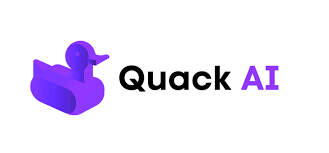QuackAI’s DuckChain blockchain is a Layer-1 network, with several benefits and features.
The world of blockchain governance is undergoing a transformation, and at the heart of that shift lies Quack AI and its native ecosystem DuckChain.
DuckChain is a Layer‑1 blockchain built to be EVM‑compatible, with a focus on accessibility, low fees, and integration with messenger platforms like Telegram.
It is designed to serve as a backbone for decentralized applications (dApps), decentralized finance (DeFi) and community‑governed ecosystems.
Quack AI is the governance protocol powering DuckChain’s decision‑making architecture. Rather than relying solely on manual voting by token holders, the system incorporates autonomous AI agents to analyse proposals, monitor on‑chain & off‑chain data, and assist in governance execution.
Together they aim to solve key governance problems: low voter participation, concentration of voting power, and slow decision‑making in traditional DAO models.
Architecture and Key Features of QuackAI DuckChain
DuckChain’s technical foundation emphasises modularity, multi‑chain bridges and user‑friendly engagement. It supports fast transaction throughput, simplified wallet integration, and a governance layer built natively.
Into this framework, Quack AI introduces the following features:
- AI Agents: Token holders may delegate governance rights to pre‑configured AI agents. These agents analyse proposals, vote on behalf of users based on preferences or learnt behaviour, and execute approved actions automatically.
- Proposal Scoring & Automation: Quack AI assesses proposals in real time, weighing criteria like community sentiment, on‑chain metrics, risks, and alignment with ecosystem goals. Once a proposal passes thresholds, the system may trigger on‑chain execution steps.
- Cross‑Chain Governance: Although DuckChain is the native chain, Quack AI is built to be extensible, allowing governance modules to operate across multiple networks beyond just one chain.
- Token Incentives & Participation: DuckChain issues its native token (commonly known as $DUCK) to fuel transactions, staking, governance participation and ecosystem rewards. Genesis members in the AI‑DAO model also receive unique privileges via soulbound tokens.
These building blocks mark a departure from the standard DAO governance model where users passively vote and rely on manual execution. Instead, Quack AI introduces a semi‑autonomous system with human‑agent collaboration.
Governance Model & Community Engagement
One of the major selling points of Quack AI is its focus on increasing engagement. Traditional governance systems in decentralised organisations often see very low participation, say under 10% of token holders, leaving decisions to a small minority. Quack AI attempts to bridge the gap by making participation easier and more automated.
For early adopters, DuckChain’s “AI DAO Genesis Member” program offers a path to join the governance ecosystem, receive soulbound‑token membership, and delegate governance functions to AI agents. These members share in token rewards, gain early access and help shape governance tooling.
The system also seeks to reduce dominance by large token holders: by automating votes and setting rules for agent behaviour, the influence of individual whales is moderated, and the protocol claims to achieve more equitable decision‑making.
By combining AI‑driven decision flows and user incentives, DuckChain and Quack AI hope to build a more active community, faster proposal lifecycle and more transparent execution of governance outcomes.
QuackAI DuckChain Use Cases, Ecosystem & Token Dynamics
DuckChain supports a wide array of ecosystem projects — gaming, NFTs, DeFi protocols, and cross‑chain bridges. Because of its low‑cost structure and Telegram‑friendly integration, it appeals to users migrating from Web2 messenger communities into Web3 environments.
Quack AI’s governance engine is already being deployed in real‑world contexts: for example, asset‑management decisions, treasury allocations, and community‑driven game economy updates. Its modular integration allows other chains or projects to “plug in” governance logic without starting from scratch.
The token economics are central. The native token (DUCK) is used for gas fees, staking, liquidity, governance rights and rewards. Its supply dynamics, vesting schedules and participation incentives influence the governance system’s health: higher staking and active governance tend to improve stability and trust.
Roadmap & Forward Strategy
Looking ahead, the roadmap for DuckChain and Quack AI is ambitious:
- Expand the AI agent interface so more token holders can delegate or customise agents for their own preferences.
- Improve cross‑chain interoperability, allowing governance to span networks like Ethereum, TON, BNB Chain and beyond.
- Release developer‑facing APIs and SDKs so dApps can integrate Quack AI governance modules seamlessly.
- Increase ecosystem growth: more projects launching on DuckChain, more liquidity, more user‑friendly interfaces (especially via Telegram).
Should these milestones play out, the pair aim to redefine how Web3 communities organise, vote and execute decisions — shifting from manual, often sluggish DAO models into faster, AI‑assisted governance.
Risks & Considerations
While the model is promising, several risks are worth noting.
First: automation in governance can reduce human oversight. If AI agents are mis‑configured or biased, decisions might stray from community intent. Ensuring transparency and auditability is essential.
Second: cross‑chain and interoperability ambitions are technically challenging. Competing chains and governance frameworks exist; delivering on promises will require robust engineering and adoption.
Third: token dynamics and participation matter. If governance delegates to AI agents but token holders disengage, actual decentralisation could weaken. The protocol needs broad participation to succeed.
Finally: the broader crypto market environment is volatile; project success depends not just on technology but also on real‑world adoption, community activity, regulatory clarity and ecosystem momentum.
Why It Matters
The Quack AI + DuckChain initiative matters because governance has long been the Achilles’ heel of decentralised systems. Many DAOs struggle with low turnout, slow execution and centralisation of power.
By introducing AI agents, automated voting processes and cross‑chain capability, this ecosystem offers a glimpse into the next generation of governance designs — ones that could scale with thousands of participants rather than dozens, and execute decisions in hours rather than weeks.
For builders, investors and users, the project signals that Web3 is moving beyond token launches and into infrastructure for autonomous community coordination, decision‑making and execution. For governance theorists and blockchain researchers, it is a live case‑study of how AI and decentralised governance might merge.







